Web Applications is a start-up company offering Web-based business management applications. Online Office Manager, our Internet-based application, allows users to stay connected and work remotely. It provides all the necessary tools of a physical office, allowing for 24-hour access. Users can subscribe to our server to access Online Office Manager.
Like any start-up, Web Applications acknowledges the risks involved. We are focused on understanding industry trends, customer needs, and how to effectively address those needs.
We aim to thrive in the computer applications software industry, one of the fastest-growing segments in the computer industry. The worldwide software market generated $122 billion in revenue two years ago, with a 15% increase from the previous year. This growth continued last year, and projections by IDC indicate a compound annual growth rate of approximately 12%, leading to over $220 billion in revenue in three years.
To start, we are seeking moderate investment and expect a 10-fold growth in revenue in year one. Achieving profitability within six months is our primary goal.
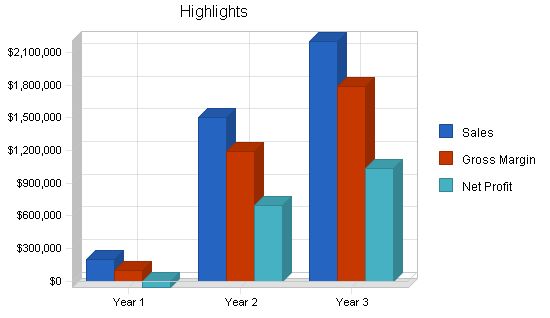
Web Applications’ mission is to connect workers in different locations to their mother company through an online office system.
Web Applications, Inc. was founded in 1998 to offer a Web-based business application that allows users to stay connected with operations from anywhere in the world. The company was established by Mr. Lester Andrews and is a Georgia incorporated S-Corporation.
Start-up costs, expenses, and funding sources are detailed in the tables and chart below.
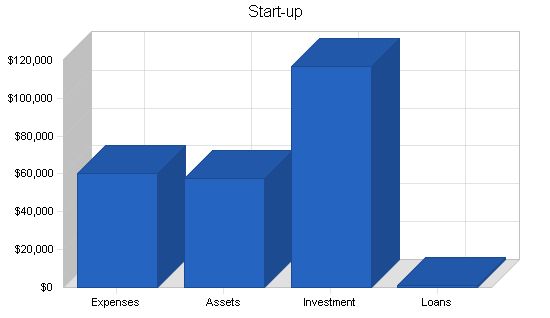
Start-up Funding
Start-up Expenses to Fund: $60,100
Start-up Assets to Fund: $57,500
Total Funding Required: $117,600
Assets
Non-cash Assets from Start-up: $5,000
Cash Requirements from Start-up: $52,500
Additional Cash Raised: $0
Cash Balance on Starting Date: $52,500
Total Assets: $57,500
Liabilities and Capital
Liabilities
Current Borrowing: $0
Long-term Liabilities: $0
Accounts Payable (Outstanding Bills): $1,000
Other Current Liabilities (interest-free): $0
Total Liabilities: $1,000
Capital
Planned Investment
Investor 1: $15,000
Investor 2: $101,600
Other: $0
Additional Investment Requirement: $0
Total Planned Investment: $116,600
Loss at Start-up (Start-up Expenses): ($60,100)
Total Capital: $56,500
Total Capital and Liabilities: $57,500
Total Funding: $117,600
Start-up
Requirements
Start-up Expenses
Legal: $500
Stationery etc.: $300
Sales Campaign: $5,000
Dynamic Communications fees: $4,200
Phone Lines: $800
Rent: $800
Hardware: $23,500
Software: $25,000
Total Start-up Expenses: $60,100
Start-up Assets
Cash Required: $52,500
Other Current Assets: $5,000
Long-term Assets: $0
Total Assets: $57,500
Total Requirements: $117,600
2.2 Financial Risks and Contingencies
The company recognizes that it is subject to both market and industry risks. We believe our risks are as follows, and we are addressing each as indicated.
-Start-up company: We face all the risks associated with being a start-up company. We feel that we can overcome these with our experience in the industry and by quickly establishing desired relationships.
-Security: Security is a major issue, but all features provide security options; documents and directories can be password-protected and have specific, user-only access rights.
Services
Web Applications has developed an Internet-based application called Online Office Manager, for which a patent is pending. Online Office Manager allows businesses and individuals to keep in touch effectively even with a distance factor. Online Office Manager provides applications which replace the physical office. With Online Office Manager, your office moves with you at all times and you have 24-hour access to it. Users can get Online Office Manager by subscribing to our server on the Internet. There is no need to buy any software or upgraded versions of the software.
3.1 Service Description
Main Features
-Communication and productivity: This feature will allow you to see who is online within an organization. Our communication feature will enable the user to initiate and conduct a chat session, and will give them the means to initiate NetMeeting. Users can send and receive files directly through the Internet. Documents can also be stored in one central location.
-Email: Users will be able to send and receive emails and faxes in a personal mailbox. Within the email tool, users can create and use different folders to hold their private email. They will also have quick access to folders in an organization, and the ability to create and maintain an address book.
-Messaging: Users will be able to send text messages to others online. This feature will receive and log messages giving a “while you were out” type application.
-Schedules: Scheduling meetings can be done en-mass, i.e. users select a group of users and request a meeting. They can also specify which users must be present for the meeting to occur, and which are optional. When confirmations are received for all those required, a message is placed on everyone’s calendar. The user will also be able to set up scheduled reminders that fire off at a certain time. The system can maintain a database of resources. For the individual users, they can store their own personal schedule.
-Document Management: Users can store different documents on the system. Checked-in documents are saved in a manner which will allow for easy retrieval at a later time. Document searching can be done using a keyword, and the document can be viewed in a number of different formats without having to install any software.
Secondary Features
-Online bill payments: This service will be name branded from services like Checkfree. It will allow users to electronically pay bills all in one location.
-Threaded bulletin board: This allows users to leave messages and multiple individuals to respond, leave their own message, and track the history.
-Package tracking: Users can view the status of packages that are being shipped with FedEx, UPS, etc.
-Travel planner: Will allow users to make travel arrangements and get discounts. Users can create travel profiles and itineraries online.
-Credit check services: This will allow users to check credit ratings of potential business partners or vendors.
-Conduct surveys: Users can create a survey and distribute it on the system. Responses can be given and returned to the system where they will be tabulated and maintained.
Online Office Manager comes in three packages and customers can choose the one with the applications that best suit their needs.
3.2 Future Services
In the future, we will implement Phase 2 of our plan. Our research and development (R&D) will yield innovation with input from customers and the marketplace. Given below is a detailed look at the future applications that will be a part of the Phase 2 program. The biggest and most complex application of Phase 2 will be the telephone/fax service.
Telephone/Fax services.
A full-blown phone messaging service will be provided, and users can get a number on our phone network from which they can get messages. The existence of messages will be indicated in the user mailbox and the user can play them over the computer (sound card and speakers are required). The same number can also be used to receive faxes. Faxes will be received and stored in one central location, then placed in the user mailbox. The user can then retrieve them in an image, forward them to a real fax machine, or forward them to an email address. The user will also be able to fax documents over the Internet through our system. They can drag and drop a document on the fax button, give a phone number, and the document will be routed to our system and automatically faxed to the desired number (long distance charges will be added to the bill). The service will allow two people to connect over the Internet using a microphone and speakers as a Web-phone (this will provide great savings on long distance phone calls).
Other Future Applications
-Work flow: Enables sales representatives in the field to initiate customer orders with auto-routing approval and notification management.
-Company activities planner: Increase access to information about company activities.
-Online purchasing system: For order entry, inventory tracking, and office supplies and equipment.
-Time sheet reporting: Enables employees to fill out daily time sheets online and route them into the responsible department using a project name or unique ID.
-Knowledge-based application: Provides a discussion database for sharing knowledge and information that is valuable within the company.
-Vacation request: Individuals can request vacation time and managers can approve or reject the request online.
-While you were out application: Will enable messages to be taken and sent to the user’s mailbox.
-Account tracking application: For salespersons, this feature will provide a process for tracking customer information and competitive opportunities.
-Job postings: Enables people to browse various categories and sub-categories of ads and submit resumes.
Market Analysis Summary
We expect to compete as a thriving company in the computer applications software industry. Applications software is computer programs designed to accomplish user tasks, such as word processing, graphic design, desktop publishing, inventory control, and more. The software industry consists of three general market segments: application solutions, application tools, and systems software. The software market has long been one of the computer industry’s fastest-growing segments. Revenues for the worldwide software market reached $122 billion in 1997, up about 15% from 1996 according to estimates by IDC. Revenues continued to show robust growth in 1998. IDC projects that revenues will grow at a compound annual rate of approximately 12% for the next several years, surpassing $220 billion by 2002.
Applications software includes programs that perform specific industry or business functions. The worldwide market for applications software increased to $56 billion in 1997, a 17% rise over 1996, and is expected to grow 15% annually through 2001, to approximately $98 billion.
Application tools include data access and retrieval, data management, data manipulation, and program design and development software. The worldwide application tool software market grew 13% in 1997, to $31 billion. It should continue to increase 12% to 13% annually, approaching $50 billion by 2002.
System-level software comprises operating systems, operating systems enhancements, and data center management. The worldwide market for system-level software increased 13% in 1997, to $35.1 billion. This figure should exceed $53 billion by 2001, based on an 11% compound annual growth rate (CAGR).
Applications software can be either developed by outside vendors and sold in packaged form or custom-made by users themselves. Many computer users don’t have the time or desire to write their own computer programs or to hire a software developer; they can choose from thousands of quality packaged programs ready for use with little or no modification. The proliferation of computers has increased the number of people who use computers relative to those who can program them, increasing the packaged software’s importance. Custom software is tailored to the needs of a specific individual or organization.
4.1 A Brief Look at the Internet
In just five years, the Internet has undergone a major metamorphosis. From an obscure network used by a limited number of academics and researchers, the Internet has been transformed into a global Web of more than 100 million interconnected computers encompassing users from all walks of life. Described below are the various segments of the Internet:
-Hardware: networking equipment. This sector provides the primary infrastructure on which the Internet is built. Two prominent types of network equipment are routers and remote access concentrators. Cisco Systems Inc. with sales of approximately $9.9 billion and a market share of 67%, dominated the routers market in 1998. Ascend Communications, Inc. (1998 sales of $1.48 billion) and Cisco share leadership of the remote access concentrator market, with shares of approximately 28% and 27%, respectively.
-Software: Two of the main types of Internet software are browsers and security programs. Microsoft Corporation and Netscape Communications Corporation dominate the key software component of the World Wide Web. The security segments are needed to ensure the safety of networks and transactions. Security Dynamics Technology Inc. (1998 sales of $41 million) has taken the lead in providing authentication and encryption products.
-Services: Internet service providers (ISPs) offer a way for people to enter the Internet. According to IDC, America Online has approximately 43% share of the total subscribers in the ISP segment, followed by Microsoft’s MSN and AT&T’s WorldNet.
-Destinations: Destinations are websites that people can go to for information, entertainment, or commerce.
4.2 Brief Look at the Computer Industry
In the first six months of 1997, a total of 37 million personal computers (PC) were shipped worldwide. That figure rose to 40 million during the same time period in 1998 and, according to IDC, this figure is expected to rise by 16% in 1999. PC growth in 1997 and 1998 was boosted by the introduction of the sub-$1,000 PC. This price point is due in large part to the sharp drop in prices of the major components that go into the PC. Another way PC makers have addressed lower price points is through cost-reduction efforts made possible by new manufacturing and distribution strategies. Two important initiatives are underway:
-Build to order (BTO). Under BTO, PCs are assembled by the manufacturer.
-Channel assembly. Under channel assembly, distributors or resellers build and configure the machines.
In both cases, the building or configuring occurs when an order is received. By using these methods, indirect PC vendors hope to keep inventories lower and, through the cost savings achieved, offer more competitive prices to customers. Compaq, Dell, IBM, and Hewlett Packard dominate the computer industry.
4.3 Market Segmentation
A review of all of our markets is given below:
-Small businesses: According to trends, the Internet will no longer be just a marketing vehicle; it will become the backbone of a company’s business infrastructure. Companies use the Internet to set up homepages that describe their products and lines of business. This gives them an excellent medium to raise their profile, advertise products, and recruit employees.
-Individuals: As of the year-end 1998, almost 100 million users accessed the Internet regularly, up from 69 million at the end of 1997, according to IDC. A key factor in the recent growth of the Internet is the popularity of the sub-$1,000 PC. Computers sold at or below $1,000 have appealed to first-time PC users and lower-income families. In the United States, less than one-third of the population is connected, leaving plenty of room for growth. When consumers are asked why they purchased a PC, the most common answer is to connect to the Internet. Individual investors have been attracted in growing numbers to the ease and convenience provided by online investing websites such as E*Trade and eSchwab.
-Corporations: Half of the total number of large U.S. and European organizations have developed corporate Intranets, which use the infrastructure and standards of the Internet for internal company networks that link employees. Corporations have discovered that the technologies employed by the Internet, particularly the infrastructure and standards of the World Wide Web, are an inexpensive and powerful alternative to other forms of internal corporate communication.
-Telecommuters: Telecommuting seems to be on a steady growth curve, with approximately 11 million telecommuters in the U.S. today, according to the latest survey from FIND/SVP, a research and consulting firm. Telecommuting will continue to grow because there are frequent references to productivity gains in the range of 15-25% for telecommuters.
Customer Buying Criteria
Customers are expected to use our services based on traditional factors:
-Price: Pricing is one of our competitive advantages. We offer prices that are lower than those of any of our competitors.
-Service: Customers not only expect the best service but value for money, which is what we give them in our product.
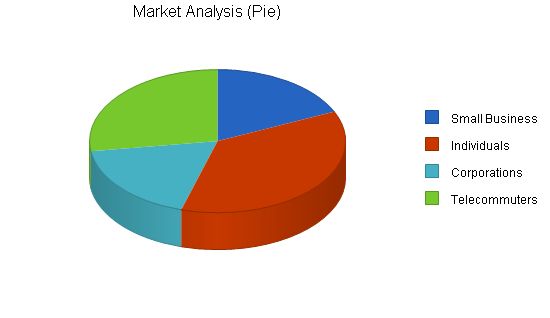
Market Analysis
| Market Analysis | |||||||
| Year 1 | Year 2 | Year 3 | Year 4 | Year 5 | |||
| Potential Customers | Growth | ||||||
| Small Business | 10% | 500,000 | 550,000 | 605,000 | 665,500 | 732,050 | 10.00% |
| Individuals | 35% | 1,000,000 | 1,350,000 | 1,822,500 | 2,460,375 | 3,321,506 | 35.00% |
| Corporations | 10% | 500,000 | 550,000 | 605,000 | 665,500 | 732,050 | 10.00% |
| Telecommuters | 25% | 750,000 | 937,500 | 1,171,875 | 1,464,844 | 1,831,055 | 25.00% |
| Total | 24.55% | 2,750,000 | 3,387,500 | 4,204,375 | 5,256,219 | 6,616,661 | 24.55% |
4.4 The Y2K Issue
One of the pressing issues facing the computer industry is the Year 2000 problem, also known as “Y2K” and “the millennium bug.” If not addressed properly, this problem will cause many computers worldwide to malfunction. Y2K arises from the fact that until the mid-1980s, programmers used two-digit numbers to represent years. For example, “97” represented the year 1997. While this design saved computer storage space, it also resulted in all dates input referring to the twentieth century. The Gartner Group, an IT consulting firm, estimates worldwide repair bills in the $300 billion – $600 billion range, but this only includes the cost of fixing Cobol programs. Software Productivity Research, a software-consulting firm, has made a broader estimate that includes repairs, damages, and litigation. This group estimates that the total cost from 1994 to 2005 will exceed $3.6 trillion.
Our products will not be affected by the Y2K problem.
4.5 Service Business Analysis
Competition
We will be competing with HotOffice Technology, a major company in the industry. Their product, HotOffice, is a low-end business planner that focuses on basic business structure. Other companies in the industry specialize in one of the many features we offer.
HotOffice Technology
HotOffice Technologies, Inc. is a Web-based Intranet Service provider for small businesses, especially those with collaboration needs. HotOffice offers small businesses an affordable, secure Intranet solution at a fraction of the cost of purchasing and maintaining a traditional Intranet or Extranet. This subscription service provides a large suite of collaboration and communication tools in one simple, easy-to-use interface accessible anytime, anywhere. From any PC with Internet access, HotOffice provides instant connection via the Web to email, calendar, documents, bulletin boards, online conference rooms, business centers, and more.
Strengths
HotOffice has large penetration in the main channels and is the first to enter the market. However, we plan on gaining a significant market share within a few months by providing additional features that will be more attractive for users.
Weaknesses
- Their products are low-end and only aimed at business users. Our product, with its advanced features, will surpass that of HotOffice.
- Their products have no programming capabilities.
- There are other companies in the industry.
- These companies offer one form of the many applications we offer. They specialize in selling hard drive space or email functions.
Barriers to Entry
Web Applications will benefit from several significant barriers to entry:
- We have a development team that is up to date with the latest industry applications. With this team, we believe we will dominate the industry and continue to enhance our product over time.
- Our product has multi-dimensional applications, making it difficult for newcomers to duplicate what we have.
- Once we are established in the market, it will be difficult for someone to break into a market where someone is already operating successfully.
Strategy and Implementation Summary
We aim to become the leading provider of Web-based business management applications in the market. We will achieve this by developing an innovative and progressive development and management team. Customer input will also play a crucial role in further developing our products and services.
We will leverage this new product in the computer software industry to dominate the growing Web-based applications market, especially for small businesses. We offer a premium, value-added product with three different packages for users to choose from. These strategic product lines will enable us to dominate the target market. The products share core applications but differ in services.
As a company, we believe there are a number of opportunities we can capitalize on:
Small Businesses
- Improved communication, allowing businesses to set up meetings without incurring travel costs.
- An alternative to office networks and additional hardware expenses.
- Cost-effectiveness through monthly fees instead of high setup costs and servers.
Corporate
- Assistance in setting up the system and easing the transition at main branch offices.
- Empowering the sales department with quick approvals and faster deal closures.
- Eliminating the need for laptops by placing user information online and in various departments, reducing the risk of theft.
Individuals
- Eliminating the need for multiple software packages by providing all necessary applications in one place.
- A portable personal information manager (PIM) that keeps users informed of special events, even while traveling.
- Eliminating the need for laptops by placing user information online and in various departments, reducing the risk of theft.
We will outsource all sales operations to a company to be named.
5.1 Sales Forecast
We are confident that our Online Office Manager will be embraced by mobile computer-using businesses and e-commerce businesses. We forecast a 10-fold revenue increase over the years covered in this plan, as shown in the table and charts below.
Performing a SWOT analysis of your business is essential for developing good business strategies. Learn how to perform a SWOT analysis with our free guide and template.
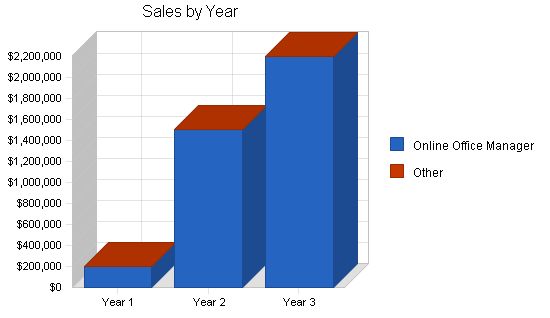
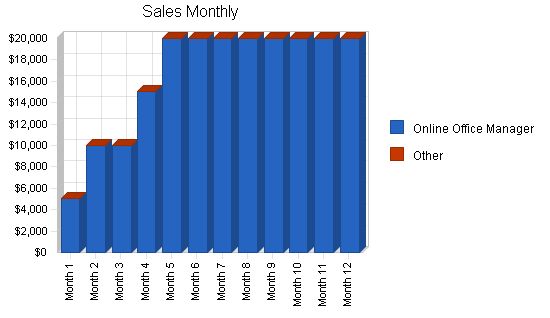
Sales Forecast:
Year 1 Year 2 Year 3
Sales
Online Office Manager $200,000 $1,500,000 $2,200,000
Other $0 $0 $0
Total Sales $200,000 $1,500,000 $2,200,000
Direct Cost of Sales:
Year 1 Year 2 Year 3
Online Office Manager $100,000 $300,000 $400,000
Other $0 $0 $0
Subtotal Direct Cost of Sales $100,000 $300,000 $400,000
5.2 Marketing Strategy:
We will outsource all marketing operations to Dynamic Communication Solutions because they have effective marketing channels and stability. Their brief promotional plan for our value-added applications includes internet, public relations, trade shows, and industry conferences and seminars. We will also follow a print advertising program in publications such as Creative Loafing, Belleview Business Chronicle, and Buckhead Local Paper.
5.3 Pricing Strategy:
Our pricing will be based on competitors’ and market prices for similar off-the-shelf products. The automatic upgrade and product enhancement features do not affect the price. Monthly, six-month, and yearly payment options will be available.
Gold Silver Bronze
$29.95 $25.95 $12.95
5.4 Value Proposition:
Web Applications offers the following value propositions for customers:
– Collaboration: Users can work on the same document simultaneously from different locations.
– Communication: Real-time communication for rapid decision-making.
– Document management: Easy storage, viewing, and searching of documents.
– Information sharing: Quick and secure sharing of information.
– Personal virtual office: Access to personal office space from anywhere.
5.5 Strategic Alliances:
We plan to form alliances with Dynamic Communication Solutions, For Sale By Internet, and a sales company (to be announced) to outsource marketing, website development, and sales operations respectively. Research alliances may also be developed to adapt the product to new markets.
Management Summary:
Web Applications has a management team that encourages creativity and achievement. The key management team includes Mr. Lester Andrews and Mr. Dwight Austin.
6.1 Management Team:
Mr. Lester Andrews – President and CEO:
Lester Andrews has over 10 years of experience in the Information System field. He graduated with a degree in Electronics Engineering from the DeVry Institute of Technology in 1987. He has worked for Vanstar and as a Manager of Information Systems for the Medicare SMART program.
Mr. Dwight Austion – COO/CFO:
Mr. Austion has a degree in Sociology and managerial experience. He has worked at Turner Broadcasting Systems, Taylor and Mathis/Beacon properties, Flower’s Baking Company, and Hospital Housekeeping Systems.
Personnel Plan:
Year 1 Year 2 Year 3
Lester Andrews $34,788 $43,478 $52,174
Dwight Austion $34,788 $43,478 $52,174
Service Manager $26,076 $32,609 $34,788
Other $0 $46,087 $95,647
Total People 3 5 7
Total Payroll $95,652 $165,652 $234,783
6.2 Outside Support:
For Sale By Internet – Website Developer:
For Sale By Internet is led by Webmaster, Mr. Brian Taylor, who has eight years of experience in website development.
Dynamic Communication Solutions – Marketing:
Dynamic Communication Solutions is a company with over ten years of experience in marketing and marketing management.
To be announced – Sales:
Sales operations will be outsourced to a company to be named.
To be announced – Customer service:
Customer service will be outsourced to an answering service.
We are requesting an investment of $101,600 for equipment and initial operating expenses. Additional capital investment will be required for Phase 2 operations.
Exit/Payback Strategy:
We can provide an exit for this investment within three years through a dividend of excess profits.
Conclusion:
Based on our projections, we feel that investing in Web Applications is a sound business investment. We are requesting an investment of $101,600 as soon as possible.
7.1 Break-even Analysis:
Web Applications calculates that it will break even at the sales volume presented in the table and chart. The company aims to reach this level by the end of 2000.
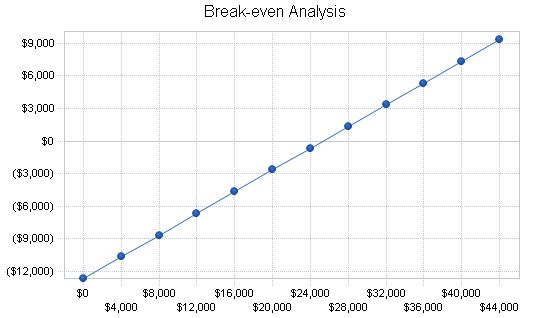
Break-even Analysis
Monthly Revenue Break-even: $25,333
Assumptions:
– Average Percent Variable Cost: 50%
– Estimated Monthly Fixed Cost: $12,667
Important Assumptions
The following chart contains assumptions crucial to the company’s success.
General Assumptions
Year 1 Year 2 Year 3
Plan Month 1 2 3
Current Interest Rate 10.00% 10.00% 10.00%
Long-term Interest Rate 10.00% 10.00% 10.00%
Tax Rate 25.42% 25.00% 25.42%
Other 0 0 0
Projected Profit and Loss
The projected income statement for Web Applications is shown below. The company is basing its revenue projections on anticipated product sales.
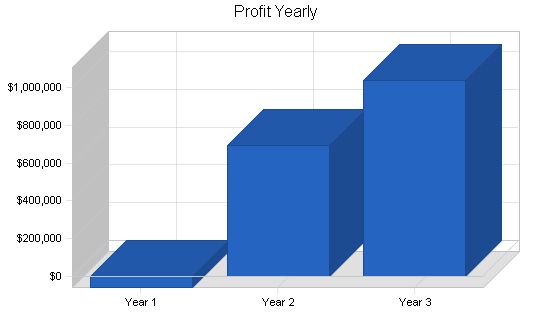
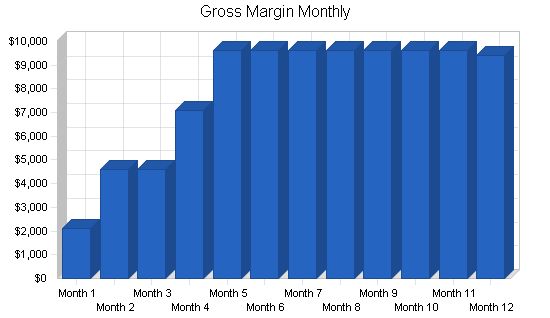
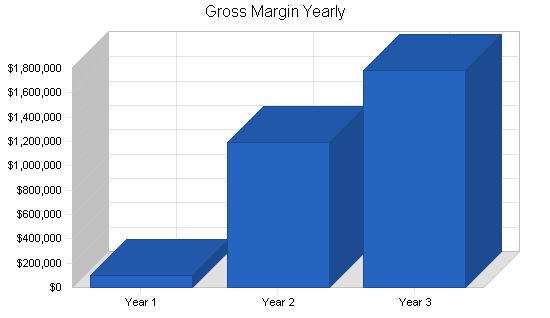
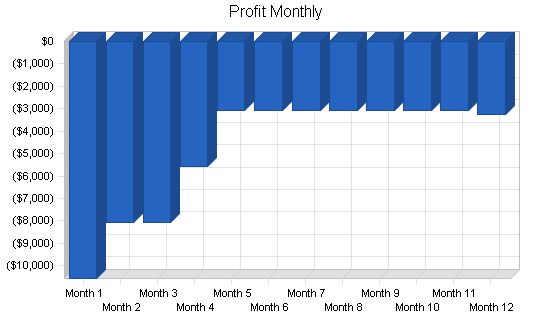
Pro Forma Profit and Loss:
Sales: $200,000, $1,500,000, $2,200,000
Direct Cost of Sales: $100,000, $300,000, $400,000
Other: $5,000, $10,000, $15,000
Total Cost of Sales: $105,000, $310,000, $415,000
Gross Margin: $95,000, $1,190,000, $1,785,000
Gross Margin %: 47.50%, 79.33%, 81.14%
Expenses:
Payroll: $95,652, $165,652, $234,783
Sales and Marketing and Other Expenses: $23,400, $47,000, $80,000
Depreciation: $0, $0, $0
Research and Development: $15,000, $25,000, $40,000
Utilities: $600, $800, $1,000
Insurance: $600, $800, $1,000
Rent: $2,400, $3,000, $5,000
Payroll Taxes: $14,348, $24,848, $35,217
Other: $0, $0, $0
Total Operating Expenses: $152,000, $267,100, $397,000
Profit Before Interest and Taxes: ($57,000), $922,900, $1,388,000
EBITDA: ($57,000), $922,900, $1,388,000
Interest Expense: $0, $0, $0
Taxes Incurred: $0, $230,725, $352,783
Net Profit: ($57,000), $692,175, $1,035,216
Net Profit/Sales: -28.50%, 46.15%, 47.06%
7.4 Projected Cash Flow:
The cash flow statement can be found in the chart and table below.
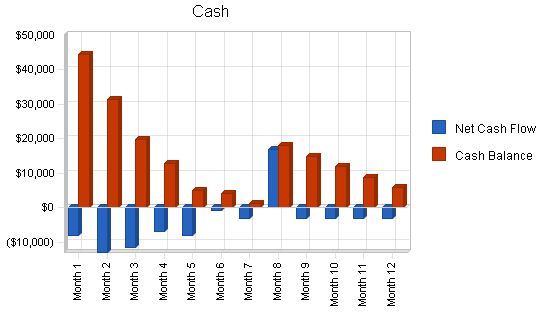
Pro Forma Cash Flow
Year 1 Year 2 Year 3
Cash Received
Cash from Operations
Cash Sales $50,000 $375,000 $550,000
Cash from Receivables $120,500 $933,250 $1,546,750
Subtotal Cash from Operations $170,500 $1,308,250 $2,096,750
Additional Cash Received
Sales Tax, VAT, HST/GST Received $0 $0 $0
New Current Borrowing $0 $0 $0
New Other Liabilities (interest-free) $0 $0 $0
New Long-term Liabilities $0 $0 $0
Sales of Other Current Assets $0 $0 $0
Sales of Long-term Assets $0 $0 $0
New Investment Received $36,000 $0 $0
Subtotal Cash Received $206,500 $1,308,250 $2,096,750
Expenditures
Year 1 Year 2 Year 3
Expenditures from Operations
Cash Spending $95,652 $165,652 $234,783
Bill Payments $147,562 $604,177 $906,344
Subtotal Spent on Operations $243,214 $769,829 $1,141,127
Additional Cash Spent
Sales Tax, VAT, HST/GST Paid Out $0 $0 $0
Principal Repayment of Current Borrowing $0 $0 $0
Other Liabilities Principal Repayment $0 $0 $0
Long-term Liabilities Principal Repayment $0 $0 $0
Purchase Other Current Assets $0 $0 $0
Purchase Long-term Assets $10,000 $0 $0
Dividends $0 $0 $0
Subtotal Cash Spent $253,214 $769,829 $1,141,127
Net Cash Flow ($46,714) $538,421 $955,623
Cash Balance $5,786 $544,207 $1,499,830
Projected Balance Sheet
Year 1 Year 2 Year 3
Assets
Current Assets
Cash $5,786 $544,207 $1,499,830
Accounts Receivable $29,500 $221,250 $324,500
Other Current Assets $5,000 $5,000 $5,000
Total Current Assets $40,286 $770,457 $1,829,330
Long-term Assets
Long-term Assets $10,000 $10,000 $10,000
Accumulated Depreciation $0 $0 $0
Total Long-term Assets $10,000 $10,000 $10,000
Total Assets $50,286 $780,457 $1,839,330
Liabilities and Capital
Year 1 Year 2 Year 3
Current Liabilities
Accounts Payable $14,786 $52,781 $76,438
Current Borrowing $0 $0 $0
Other Current Liabilities $0 $0 $0
Subtotal Current Liabilities $14,786 $52,781 $76,438
Long-term Liabilities
$0 $0 $0
Total Liabilities $14,786 $52,781 $76,438
Paid-in Capital $152,600 $152,600 $152,600
Retained Earnings ($60,100) ($117,100) $575,075
Earnings ($57,000) $692,175 $1,035,216
Total Capital $35,500 $727,675 $1,762,892
Total Liabilities and Capital $50,286 $780,457 $1,839,330
Net Worth $35,500 $727,675 $1,762,892
Sales Growth 0.00% 650.00% 46.67% 10.40%
Percent of Total Assets
Accounts Receivable 58.66% 28.35% 17.64% 24.10%
Other Current Assets 9.94% 0.64% 0.27% 42.90%
Total Current Assets 80.11% 98.72% 99.46% 71.10%
Long-term Assets 19.89% 1.28% 0.54% 28.90%
Total Assets 100.00% 100.00% 100.00% 100.00%
Current Liabilities
Accounts Payable 29.40% 6.76% 4.16% 47.80%
Long-term Liabilities 0.00% 0.00% 0.00% 19.10%
Total Liabilities 29.40% 6.76% 4.16% 66.90%
Net Worth 70.60% 93.24% 95.84% 33.10%
Percent of Sales
Sales 100.00% 100.00% 100.00% 100.00%
Gross Margin 47.50% 79.33% 81.14% 0.00%
Selling, General & Administrative Expenses 76.00% 33.19% 33.82% 82.10%
Advertising Expenses 9.00% 2.67% 3.18% 1.20%
Profit Before Interest and Taxes -28.50% 61.53% 63.09% 2.00%
Main Ratios
Current 2.72 14.60 23.93 1.30
Quick 2.72 14.60 23.93 1.03
Total Debt to Total Assets 29.40% 6.76% 4.16% 66.90%
Pre-tax Return on Net Worth -160.56% 126.83% 78.73% 3.10%
Pre-tax Return on Assets -113.35% 118.25% 75.46% 9.30%
Additional Ratios
Net Profit Margin -28.50% 46.15% 47.06% n.a
Return on Equity -160.56% 95.12% 58.72% n.a
Activity Ratios
Accounts Receivable Turnover 5.08 5.08 5.08 n.a
Collection Days 57 41 60 n.a
Accounts Payable Turnover 10.91 12.17 12.17 n.a
Payment Days 27 19 25 n.a
Total Asset Turnover 3.98 1.92 1.20 n.a
Debt Ratios
Debt to Net Worth 0.42 0.07 0.04 n.a
Current Liab. to Liab. 1.00 1.00 1.00 n.a
Liquidity Ratios
Net Working Capital $25,500 $717,675 $1,752,892 n.a
Interest Coverage 0.00 0.00 0.00 n.a
Additional Ratios
Assets to Sales 0.25 0.52 0.84 n.a
Current Debt/Total Assets 29% 7% 4% n.a
Acid Test 0.73 10.41 19.69 n.a
Sales/Net Worth 5.63 2.06 1.25 n.a
Dividend Payout 0.00 0.00 0.00 n.a
Appendix
Sales Forecast
Month 1 Month 2 Month 3 Month 4 Month 5 Month 6 Month 7 Month 8 Month 9 Month 10 Month 11 Month 12
Sales
Online Office Manager 0% $5,000 $10,000 $10,000 $15,000 $20,000 $20,000 $20,000 $20,000 $20,000 $20,000 $20,000 $20,000
Other 0% $0 $0 $0 $0 $0 $0 $0 $0 $0 $0 $0 $0
Total Sales $5,000 $10,000 $10,000 $15,000 $20,000 $20,000 $20,000 $20,000 $20,000 $20,000 $20,000 $20,000
Direct Cost of Sales
Month 1 Month 2 Month 3 Month 4 Month 5 Month 6 Month 7 Month 8 Month 9 Month 10 Month 11 Month 12
Online Office Manager $2,500 $5,000 $5,000 $7,500 $10,000 $10,000 $10,000 $10,000 $10,000 $10,000 $10,000 $10,000 $10,000
Other $0 $0 $0 $0 $0 $0 $0 $0 $0 $0 $0 $0 $0
Subtotal Direct Cost of Sales $2,500 $5,000 $5,000 $7,500 $10,000 $10,000 $10,000 $10,000 $10,000 $10,000 $10,000 $10,000
Personnel Plan
Month 1 Month 2 Month 3 Month 4 Month 5 Month 6 Month 7 Month 8 Month 9 Month 10 Month 11 Month 12
Lester Andrews 0% $2,899 $2,899 $2,899 $2,899 $2,899 $2,899 $2,899 $2,899 $2,899 $2,899 $2,899 $2,899
Dwight Austion 0% $2,899 $2,899 $2,899 $2,899 $2,899 $2,899 $2,899 $2,899 $2,899 $2,899 $2,899 $2,899
Service Manager 0% $2,173 $2,173 $2,173 $2,173 $2,173 $2,173 $2,173 $2,173 $2,173 $2,173 $2,173 $2,173
Other 0% $0 $0 $0 $0 $0 $0 $0 $0 $0 $0 $0 $0
Total People 3 3 3 3 3 3 3 3 3 3 3 3 3
Total Payroll $7,971 $7,971 $7,971 $7,971 $7,971 $7,971 $7,971 $7,971 $7,971 $7,971 $7,971 $7,971 $7,971
General Assumptions:
Plan Month: 1 2 3 4 5 6 7 8 9 10 11 12
Current Interest Rate: 10.00% 10.00% 10.00% 10.00% 10.00% 10.00% 10.00% 10.00% 10.00% 10.00% 10.00% 10.00% 10.00%
Long-term Interest Rate: 10.00% 10.00% 10.00% 10.00% 10.00% 10.00% 10.00% 10.00% 10.00% 10.00% 10.00% 10.00% 10.00%
Tax Rate: 30.00% 25.00% 25.00% 25.00% 25.00% 25.00% 25.00% 25.00% 25.00% 25.00% 25.00% 25.00% 25.00%
Other: 0 0 0 0 0 0 0 0 0 0 0 0
Pro Forma Profit and Loss:
Sales: $5,000 $10,000 $10,000 $15,000 $20,000 $20,000 $20,000 $20,000 $20,000 $20,000 $20,000 $20,000 $20,000
Direct Cost of Sales: $2,500 $5,000 $5,000 $7,500 $10,000 $10,000 $10,000 $10,000 $10,000 $10,000 $10,000 $10,000 $10,000
Other: $400 $400 $400 $400 $400 $400 $400 $400 $400 $400 $400 $400 $600
Total Cost of Sales: $2,900 $5,400 $5,400 $7,900 $10,400 $10,400 $10,400 $10,400 $10,400 $10,400 $10,400 $10,400 $10,600
Gross Margin: $2,100 $4,600 $4,600 $7,100 $9,600 $9,600 $9,600 $9,600 $9,600 $9,600 $9,600 $9,600 $9,400
Gross Margin %: 42.00% 46.00% 46.00% 47.33% 48.00% 48.00% 48.00% 48.00% 48.00% 48.00% 48.00% 48.00% 47.00%
Expenses:
Payroll: $7,971 $7,971 $7,971 $7,971 $7,971 $7,971 $7,971 $7,971 $7,971 $7,971 $7,971 $7,971 $7,971
Sales and Marketing and Other Expenses: $1,950 $1,950 $1,950 $1,950 $1,950 $1,950 $1,950 $1,950 $1,950 $1,950 $1,950 $1,950 $1,950
Depreciation: $0 $0 $0 $0 $0 $0 $0 $0 $0 $0 $0 $0 $0
Research and Development: $1,250 $1,250 $1,250 $1,250 $1,250 $1,250 $1,250 $1,250 $1,250 $1,250 $1,250 $1,250 $1,250
Utilities: $50 $50 $50 $50 $50 $50 $50 $50 $50 $50 $50 $50 $50
Insurance: $50 $50 $50 $50 $50 $50 $50 $50 $50 $50 $50 $50 $50
Rent: $200 $200 $200 $200 $200 $200 $200 $200 $200 $200 $200 $200 $200
Payroll Taxes: 15% $1,196 $1,196 $1,196 $1,196 $1,196 $1,196 $1,196 $1,196 $1,196 $1
Pro Forma Cash Flow
| Month 1 | Month 2 | Month 3 | Month 4 | Month 5 | Month 6 | Month 7 | Month 8 | Month 9 | Month 10 | Month 11 | Month 12 | ||
| Cash Received | |||||||||||||
| Cash from Operations | |||||||||||||
| Cash Sales | $1,250 | $2,500 | $2,500 | $3,750 | $5,000 | $5,000 | $5,000 | $5,000 | $5,000 | $5,000 | $5,000 | $5,000 | |
| Cash from Receivables | $0 | $125 | $3,875 | $7,500 | $7,625 | $11,375 | $15,000 | $15,000 | $15,000 | $15,000 | $15,000 | $15,000 | |
| Subtotal Cash from Operations | $1,250 | $2,625 | $6,375 | $11,250 | $12,625 | $16,375 | $20,000 | $20,000 | $20,000 | $20,000 | $20,000 | $20,000 | |
| Additional Cash Received | |||||||||||||
| Sales Tax, VAT, HST/GST Received | 0.00% | $0 | $0 | $0 | $0 | $0 | $0 | $0 | $0 | $0 | $0 | $0 | $0 |
| New Current Borrowing | $0 | $0 | $0 | $0 | $0 | $0 | $0 | $0 | $0 | $0 | $0 | $0 | $0 |
| New Other Liabilities (interest-free) | $0 | $0 | $0 | $0 | $0 | $0 | $0 | $0 | $0 | $0 | $0 | $0 | $0 |
| New Long-term Liabilities | $0 | $0 | $0 | $0 | $0 | $0 | $0 | $0 | $0 | $0 | $0 | $0 | $0 |
| Sales of Other Current Assets | $0 | $0 | $0 | $0 | $0 | $0 | $0 | $0 | $0 | $0 | $0 | $0 | $0 |
| Sales of Long-term Assets | $0 | $0 | $0 | $0 | $0 | $0 | $0 | $0 | $0 | $0 | $0 | $0 | $0 |
| New Investment Received | $0 | $0 | $0 | $0 | $0 | $6,000 | $0 | $30,000 | $0 | $0 | $0 | $0 | $0 |
| Subtotal Cash Received | $1,250 | $2,625 | $6,375 | $11,250 | $12,625 | $22,375 | $20,000 | $50,000 | $20,000 | $20,000 | $20,000 | $20,000 | |
| Expenditures | Month 1 | Month 2 | Month 3 | Month 4 | Month 5 | Month 6 | Month 7 | Month 8 | Month 9 | Month 10 | Month 11 | Month 12 | |
| Expenditures from Operations | |||||||||||||
| Cash Spending | $7,971 | $7,971 | $7,971 | $7,971 | $7,971 | $7,971 | $7,971 | $7,971 | $7,971 | $7,971 | $7,971 | $7,971 | |
| Bill Payments | $1,253 | $7,679 | $10,096 | $10,179 | $12,679 | $15,096 | $15,096 | $15,096 | $15,096 | $15,096 | $15,096 | $15,102 | |
| Subtotal Spent on Operations | $9,224 | $15,650 | $18,067 | $18,150 | $20,650 | $23,067 | $23,067 | $23,067 | $23,067 | $23,067 | $23,067 | $23,073 | |
| Additional Cash Spent | |||||||||||||
| Sales Tax, VAT, HST/GST Paid Out | $0 | $0 | $0 | $0 | $0 | $0 | $0 | $0 | $0 | $0 | $0 | $0 | $0 |
| Principal Repayment of Current Borrowing | $0 | $0 | $0 | $0 | $0 | $0 | $0 | $0 | $0 | $0 | $0 | $0 | $0 |
| Other Liabilities Principal Repayment | $0 | $0 | $0 | $0 | $0 | $0 | $0 | $0 | $0 | $0 | $0 | $0 | $0 |
| Long-term Liabilities Principal Repayment | $0 | $0 | $0 | $0 | $0 | $0 | $0 | $0 | $0 | $0 | $0 | $0 | $0 |
| Purchase Other Current Assets | $0 | $0 | $0 | $0 | $0 | $0 | $0 | $0 | $0 | $0 | $0 | $0 | $0 |
| Purchase Long-term Assets | $0 | $0 | $0 | $0 | $0 | $0 | $0 | $10,000 | $0 | $0 | $0 | $0 | $0 |
| Dividends | $0 | $0 | $0 | $0 | $0 | $0 | $0 | $0 | $0 | $0 | $0 | $0 | $0 |
| Subtotal Cash Spent | $9,224 | $15,650 | $18,067 | $18,150 | $20,650 | $23,067 | $23,067 | $33,067 | $23,067 | $23,067 | $23,067 | $23,073 | |
| Net Cash Flow | ($7,974) | ($13,025) | ($11,692) | ($6,900) | ($8,025) | ($692) | ($3,067) | $16,933 | ($3,067) | ($3,067) | ($3,067) | ($3,073) | |
| Cash Balance | $44,526 | $31,501 | $19,809 | $12,909 | $4,884 | $4,193 | $1,126 | $18,059 | $14,993 | $11,926 | $8,859 | $5,786 |
Pro Forma Balance Sheet
| Month 1 | Month 2 | Month 3 | Month 4 | Month 5 | Month 6 | Month 7 | Month 8 | Month 9 | Month 10 | Month 11 | Month 12 | ||
| Assets | |||||||||||||
| Current Assets | |||||||||||||
| Cash | $52,500 | $44,526 | $31,501 | $19,809 | $12,909 | $4,884 | $4,193 | $1,126 | $18,059 | $14,993 | $11,926 | $8,859 | $5,786 |
| Accounts Receivable |
Hello!
I’m Andrew Brooks, a seasoned finance consultant from the USA and the mind behind phonenumber247.com.
My career is built on a foundation of helping individuals and businesses thrive financially in an ever-changing economic landscape. At phonenumber247.com, my aim is to demystify the complex world of finance, providing clear, actionable advice that can help you navigate your financial journey with confidence. Whether it’s personal finance management, investment strategies, or understanding the nuances of market dynamics, I’m here to share insights and tools that can propel you towards your financial goals.
Welcome to my digital space, where every piece of advice is a step closer to financial clarity and success!
